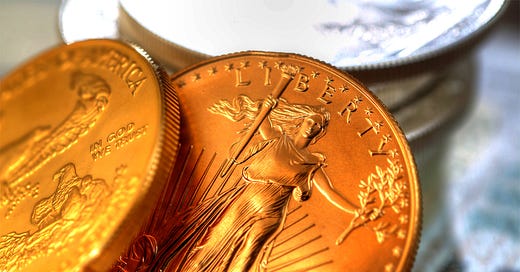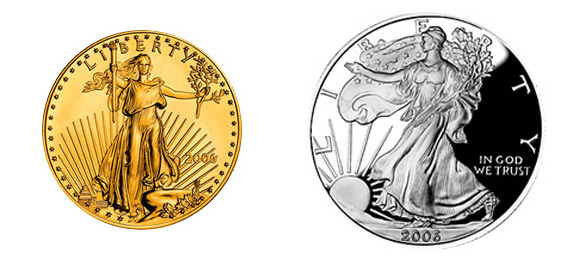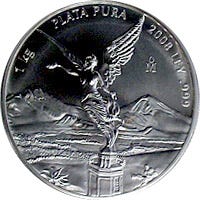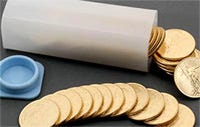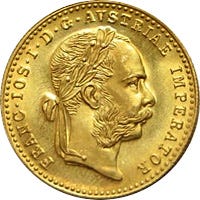Whenever the US dollar weakens, or there is troubling world news, you hear a lot of hype about buying gold and silver as a guard against financial woes. It is up to you to decide whether or not to buy gold or silver. But if you decide to buy, use these guidelines to protect yourself against rip off artists. As always, you should start small, advancing to large investments once you know the ropes.
10. Now the hard part. Recap the instructions in Part [1] and search the Internet or visit a bullion dealer to choose which coins you might buy. There are lots of choices, but remember:
Gold bullion coins or silver bullions coins dated after 1964, or
Junk silver dated before 1965 (see step 6)
Issued by a reliable government
One ounce or more
Not proof
Not slabbed
Not bars
I recommend starting with a single American gold eagle, or a few American silver eagles. They are gorgeous coins and will make your first investment experience very special.
Don't buy anything yet. Once you have your list of candidate coins, return here to figure out how much to pay.
11. Find the weight in troy ounces. All modern bullion coins are marked with the amount of precious metal they contain. Annotations such as 'one ounce pure gold' or '0.9999 fine silver' tell you the number of troy ounces of precious metal in the coin. Sometimes gold is mixed with other metals to make it stronger for minting. The annotation tells how much gold, not other metals, is in the coin.
When dealing with bullion, troy ounces and ounces are the same thing. The 'troy' is understood. Sometimes you see massive coins advertised to contain one full pound of silver. That is a lot of silver, but not as much as you may think. There are 12 troy ounces in one troy pound, not 16. To convert from pounds to ounces of precious metal, multiply by 12, not 16.
For even more confusion, consider a Mexican libertad coin with one kilogram of pure silver. There are 32.15075 troy ounces in a kilogram (look it up), so if you have 5 kilograms of silver, that is 5 x 32.15075 = 160.754 troy ounces. That’s a lot of silver!
12. Start price calculations: Compute the melt value. The first step in pricing gold or silver is computing the melt value. The melt value is the intrinsic value of the precious metal. It is as if you took a blowtorch and melted a coin into a puddle, then traded the puddle on the open market.
The melt value is sometimes called the base value (BV) or the bullion value (BV). They all mean the same thing.
You compute the melt value of gold and silver coins by multiplying their weight by the current price of gold or silver, which changes continuously but is easily accessible on the Internet. For example, if you are considering three Canadian gold maple coins, each coin with one ounce of gold, and if the current price of gold is $2000 US dollars per ounce, multiply the gold weight (three ounces) by the gold price ($2000): 3 times $2000 = $6000 melt value. It is the same thing for silver. If the spot price of silver is $20 per ounce and you have 12 ounces of silver, the melt value is 12 x 20 = $240. That's easy!
By way of example, let's assume you are buying a single 1 ounce American gold eagle and the spot price of gold is $2000. The melt value is 1 x 2000 = $2000.
Better check the actual spot prices (e.g., at kitco). The $2000 and $20 values above are for illustration only. Today’s values are different.
13. Add the value of the guarantee. The coins we have talked about are guaranteed to contain the specified amount of pure gold or pure silver. This guarantee is worth something (remember the guy with the gold-plated tungsten bars in Step 9?). Estimate how much this is worth to you and add it to the melt value. To me, $100 US dollars seems about right for the guarantee on a $2000 gold coin, but that can change with the individual and with the specific bullion coin. Using the $100 figure, that brings our $2000 example up to $2100.
14. Add the value of the packaging. Always buy coins that look nice. If a coin is stained, scratched, spotted, or otherwise marred, don't buy it. Likewise, when you buy a nice-looking coin, buy packaging that will keep it that way. Velvet-lined, diamond-encrusted jewelry cases are overkill. Simple, clear, hard plastic capsules are often used for single coins. Add in the value of the packaging and associated labor cost. Maybe $20. Our $2000 example is up to $2120.
15. Give the seller a break. It costs time and money to handle precious metal transactions, and sellers often tie up lots of their money buying inventory. Even a sales strategy as straightforward as eBay involves listing fees, final value fees, and the time, expertise and labor of setting up and executing online auctions. Estimate what this would be and add it into the price. This is your best guess at the seller's mark-up. Don't beat 'em down too much, but don't let them take you for a ride, either. You will become more comfortable with this after you complete a few transactions.
Sellers are also keenly aware of the current premiums added to gold and silver transactions. Sellers are aware of premiums, buyers, usually, are not. Premiums respond strongly to market instability and the corresponding desirability of certain types of investments. At the moment, junk silver is especially desirable, and you won’t find it sold anywhere close to melt value. Junk silver is at high premium. You can try to estimate premium yourself, but the best way to understand it is to develop good working relationships with a few trusted sellers. Again, you do this by starting small and increasing your investment activity slowly.
For a $2000 coin, a stable market with low premium, and a low-overhead sale like eBay, $100 to $200 seems a reasonable mark-up on a $2000 transaction. Our $2000 melt coin is now up to $2000 + $100 + $20 + $150 = $2270.
16. Stop adding. This is where a coin collector would add the numismatic value of the coin. It could easily double our $2270 number to $4000. Since we've ruled out numismatics, stop adding and start shopping.
17. Start shopping. Shop, shop, shop to see how close you can get to the price just calculated. If you get within a few percent you are doing well. Maybe you can even beat the calculated price.
As always, avoid 'too good to be true' prices and shady sellers. Counterfeits abound in the numismatic coin market. Reputable sellers steer clear of them. Be sure the seller guarantees that the coins are genuine. While rare for bullion coins, underweight coins can creep in. Do a reality check on all sellers until you know you can trust them. In other words, do your homework and start small.
I have had plenty of success buying and selling coins on eBay, but I would not recommend it in general. Use the large, established, well-known precious metal houses when you are just starting out. If you would like a list of CoinQuest's favorite dealers, just ask.
18. Buy. Buy one or more coins, but not too many. The usual method is to take direct possession of the gold or silver and put it in your safe deposit box. There are other venues, but physical ownership is very common. Don't worry about sending precious metal through the US mail. Mail with a tracking number is secure, and registered mail is extremely secure. Overseas mail is not as secure as domestic US mail.
Don't blow your entire investment budget until you have completed the next step. It is a difficult step, and one guaranteed to take a loss. To me, however, it is worth every effort. I wish I had done it when I was starting out.
19. Sell your coin back. Sell your coin to another person, not the one you bought it from. Do this immediately, before the overall financial picture changes.
Any bullion dealer worth his or her salt will give you an offer immediately upon seeing your coin or coins. Get a few quotes and take the best one. Run the transaction through to completion and compute the net loss buying and re-selling the same coin. For single coin transactions in the $2000 range, a 15 percent loss ($300) is pretty typical -- more if the transaction is smaller, less if it is larger. That means the market has to go up 15 percent before you start making money.
You might want to skip this step, and it is certainly optional, but the perspective changes when you are on the seller's side of the table. To me it is worth 15 percent to learn both sides. Do it early. Very early. It will help you become a better investor down the road,
20. Buy and sell in bulk. Now that you understand how gold and silver bullion works, proceed cautiously to the big time. Reputable dealers will reward you handsomely if you buy and sell in bulk. That 15 percent margin on a single coin can come down to 3 or 4 percent for bulk transactions.
If you move into large transactions over $10,000, be sure to look into laws governing large transactions. Banks and the Internal Revenue Service usually get involved at the $10,000 level.
21. Move to numismatics. After you have success in the bullion market, it might be time to move to numismatic investment. The coin in our picture is an Austrian ducat. Pretty, isn't it?
The Austrian ducat is an example of numismatic gold, but only when it is not dated 1915. Coins dated 1915 were produced later than 1915 and are made as bullion coins for bullion transactions, so they are worth their weight in gold. Coins dated between 1867 and 1914 carry numismatic premium over bullion. Investing in bullion is easy, but investing in numismatics can be tricky. Be sure you know what you are doing.

